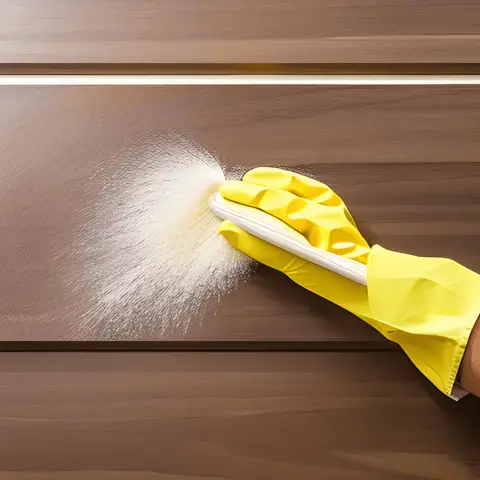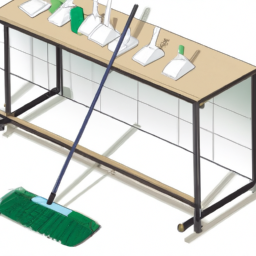How To Clean Tongue And Groove Wood Flooring
To clean tongue and groove wood flooring effectively, start by dusting or vacuuming to remove loose dirt, then use a wet/dry vacuum to clean along the grooves. For a thorough clean, use a microfiber cloth with a gentle cleaning solution, avoid abrasive cleaners, and never wet-mop the floor. Cleaning the grooves may take time, but regular maintenance will keep your floors in good condition and prevent damage.
Cleaning tongue and groove wood flooring is an essential task to maintain its beauty and durability.
As a homeowner who takes pride in my stylish floors, I understand the importance of regular maintenance.
Over time, dirt and grime can accumulate in the grooves, making it necessary to clean them thoroughly.
But fear not!
I have learned effective methods that will leave your wood floors looking sparkling clean.
In this article, I will share my knowledge and experience on how to clean tongue and groove wood flooring.
From preventing dirt and debris to choosing the right cleaning method for your specific floor finish, I will guide you through each step with detail and expertise.
Trust me, by following these simple techniques, you can restore the luster of your wood floors and ensure their longevity.
So let’s dive in and discover how easy it is to keep your tongue and groove wood flooring looking its best!
Key Takeaways
- Vacuum along every groove line with a wet/dry vacuum to remove debris.
- Mix a cleaning solution with water and dishwashing detergent or a cleaner specific to hardwood flooring to clean the grooves.
- Use a slim tool like a plastic putty knife or toothbrush for stubborn grime in the grooves.
- Follow up with another thorough vacuuming and use a dry mop method to get the wood floors sparkling clean.

How to Maintain tongue and groove wood flooring
Now let’s talk about how you can easily maintain your beautiful tongue and groove wood flooring!
Maintenance is key to keeping your floors looking their best.
Start by regularly vacuuming the floor with a powerful vacuum cleaner to remove dirt and debris from the grooves.
For a more thorough clean, use a microfiber cloth dampened with a gentle cleaning solution to wipe along the tongue and groove lines.
This will help keep your hardwood floors clean and in great condition.
Now, let’s move on to preventing dirt and debris from accumulating…
Preventing Dirt and Debris
To keep those beautiful hardwood floors looking their best, it’s crucial to take steps to prevent dirt and debris from accumulating in those hard-to-reach areas.
One effective way is to use a microfiber dust mop regularly.
It gently sweeps away dust, pet hair, and other small particles without scratching the floorboards.
Placing floor mats at entryways can also help trap dirt and prevent it from spreading onto the hardwood flooring.
Additionally, quickly cleaning up spills with a paper towel and using a mixture of white vinegar and water on a mop head can help maintain the cleanliness of your hardwood floors.
Now let’s move on to choosing the right cleaning method for your floors.
For tongue and groove wood flooring, regular cleaning routines are important to prevent dirt and debris from accumulating in the grooves.
To achieve a deep clean, choose a cleaning agent specifically designed for hardwood floors.
Use a clean cloth to apply the cleaner along the floorboards, making sure to remove any stubborn grime with gentle scrubbing.
If you prefer a professional touch, consider hiring a professional cleaning service that specializes in cleaners for hardwood floors.
With the right cleaning method, your tongue-and-groove wood flooring will stay beautiful and well-maintained for years to come.
Understanding the Floor Finish
To fully appreciate the beauty and durability of your hardwood floors, imagine a smooth and flawless surface that glistens with a protective layer, enhancing the natural grain and color of the wood.
Understanding the floor finish is crucial for choosing the right cleaning method.
Different finishes require different approaches to prevent water damage or stripping away the sealant on wood floors.
Knowing your floor’s finish will help you select the appropriate cleaning tool and hardwood floor cleaner.
Preparing the Floor for Cleaning
Before diving into the cleaning process, it’s important to ensure that your hardwood floors are properly prepared.
Start by removing any furniture or obstacles from the floor to have a clean surface.
Use a soft cloth or damp cloth with warm water to wipe away any loose dirt or dust.
For stubborn stains, avoid using steam cleaners, wax-based cleaners, or abrasive materials like steel wool.
Remember to wear protective gloves while preparing the floor for cleaning.
Now let’s discuss using the proper cleaning solution for your tongue and groove wood flooring.
Using the Proper Cleaning Solution
Once you’ve prepared your hardwood floors, it’s crucial that you select the appropriate cleaning solution to ensure optimal results.
For every 500 square feet of solid hardwood flooring, mix 1/4 cup of Bona Hardwood Floor Cleaner Spray with warm water in a bucket.
This streak-free formula effectively removes pet urine, loose dirt, and wet spills without leaving residue.
Using a microfiber mop or cloth soaked in the solution, gently clean the entire floor surface.
Now let’s move on to cleaning the grooves between the planks…
Cleaning the Grooves
Start by grabbing a thin tool like a toothbrush or plastic putty knife, and get ready to tackle the grooves between your beautiful hardwood planks.
To effectively clean these grooves, I recommend using a cleaner specifically designed for hardwood floors, such as Bona Hard Surface Floor Cleaner or Rejuvenate.
Mix the cleaner with water in a spray bottle and apply it directly to the grooves.
Then, use a microfiber mop to gently scrub the grooves, making sure to reach every crevice. Rinse with plain water and dry thoroughly.
Now let’s move on to removing stubborn grime from your wood floors without damaging them.
Removing Stubborn Grime
Get ready to tackle those stubborn stains and grime that have built up on your beautiful hardwood floors – it’s time to restore their pristine shine!
Avoid wax-based cleaners or solvent-based hardwood floor waxes, as they can leave behind residue and make the problem worse.
Instead, opt for a high-quality cleaner like Bona PowerPlus Hardwood Floor Deep Cleaner.
Start by vacuuming the area with a lightweight vacuum to remove any loose dirt or debris.
Then, apply the cleaner according to the instructions on the bottle and scrub gently with a soft brush or mop.
For deeper scratches or tough stains, you may need to use a steam cleaner or consult a professional.
Once you’ve removed the grime, wipe down the floor with a dry cloth before moving on to drying and finishing the floor.
Transition: Now that we’ve successfully removed the stubborn grime from your hardwood floor, let’s move on to drying and finishing it for that perfect final touch.
Drying and Finishing the Floor
After removing the stubborn grime from your hardwood floors, you’ll want to ensure they are thoroughly dried and finished to protect their natural beauty and shine.
To do this, use a clean dry mop or towel to remove any excess moisture left on the floor.
Next, apply a high-quality hardwood floor cleaner or polish following the manufacturer’s instructions.
This will help restore the luster of your flooring and minimize any scratches or imperfections.
Finally, allow the floor to air dry completely before proceeding with any further steps such as sanding or refinishing.
Speaking of which, if you find that your hardwood floors require more extensive care, such as deep scratches or worn areas, it may be best to consider hiring professional cleaners who specialize in hardwood floor restoration.
| Tip 1: Use a clean dry mop or towel | Tip 2: Apply a high-quality hardwood floor cleaner or polish |
|---|---|
| Using a dry mop or towel will help absorb any excess moisture on the surface of the wood and prevent water damage. | A good quality cleaner or polish specifically designed for hardwood floors will enhance their appearance and provide added protection against wear and tear. Follow the instructions on the product label for best results. |
Hiring Professional Cleaners
Now that we’ve discussed drying and finishing the floor, let’s explore the option of hiring professional cleaners.
Hiring professionals can save you valuable time and ensure a thorough clean.
They have access to commercial hardwood floor cleaners that are specifically designed to protect your floor from scratches.
Additionally, they can perform light sanding if needed and use vinegar or other suitable solutions for an effective clean.
Frequently Asked Questions
Can I use bleach to clean the grooves of tongue and groove wood flooring?
No, bleach should not be used to clean the grooves of tongue and groove wood flooring. It can damage the finish and discolor the wood.
Stick to using a mild cleaning solution or a commercial wood cleaner instead.
How often should I deep clean the grooves of my wood flooring?
Deep cleaning the grooves of wood flooring is a time-consuming task that should be done once a year.
It requires patience and thoroughness to remove dirt and grime. Hiring professionals can ensure faster and more efficient results.
Is it necessary to sand the grooves of tongue and groove wood flooring?
No, it is not necessary to sand the grooves of tongue and groove wood flooring.
Cleaning them thoroughly with a vacuum, mild cleaning solution, and a soft sponge should be sufficient for maintaining their cleanliness.
Can I use steam mop to clean the grooves of wood flooring?
Yes, you can use a steam mop to clean the grooves of wood flooring. However, be cautious as excessive moisture and heat can damage the wood.
It is recommended to test it on a small, inconspicuous area first.
What is the best way to prevent dirt and debris from accumulating in the grooves of wood flooring?
To prevent dirt and debris from accumulating in the grooves of wood flooring, I recommend using microfiber dust mops for regular cleaning and removing clutter before cleaning.
Quick, frequent cleanings a few times a week can also help keep the grooves clean.
Conclusion
After spending hours meticulously cleaning and maintaining my tongue and groove wood flooring, I couldn’t help but marvel at the stunning transformation.
The grooves that were once filled with dirt and grime now sparkled with a renewed luster. It was a labor of love, but seeing the results made it all worthwhile.
As I stepped back to admire my handiwork, I couldn’t help but wonder what other secrets lay hidden within the depths of this beautiful flooring.
With each passing year, I vow to continue exploring and uncovering its mysteries, ensuring its timeless beauty endures for generations to come.

